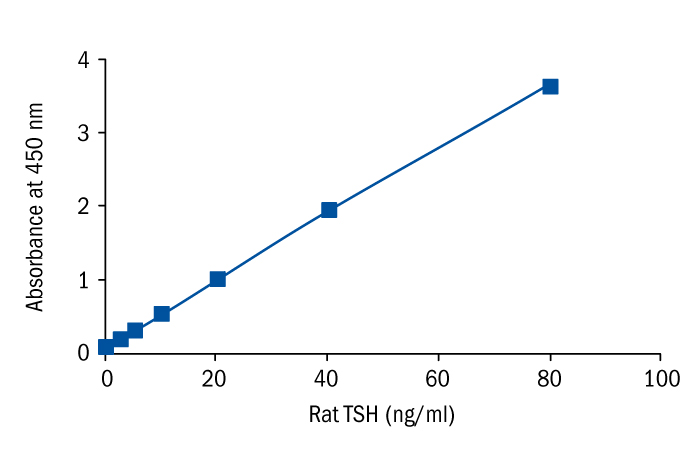Type
Sandwich ELISA, HRP-labelled antibody
Description
The BioVendor Rat TSH ELISA is an enzyme immunoassay for the quantitative measurement of TSH in rat serum. For research use only. Not for use in diagnostic procedures.
Applications
Serum
Sample Requirements
25 µl/well
Shipping
On blue ice packs. Upon receipt, store the product at the temperature recommended below.
Storage/Expiration
Store the complete kit at 2–8°C. Under these conditions, the kit is stable until the expiration date (see label on the box).
Calibration Curve
Calibration Range
2.5–80 ng/ml
Limit of Detection
0.081 ng/ml
Features
- RUO
- calibration range 2.5-80 ng/ml
- limit of detection 0.081 ng/ml
Research topic
Animal studies
Summary
Thyroid stimulating hormone (also known as thyrotropin or TSH) is a glycoprotein produced by the anterior pituitary gland. Through its action on the thyroid gland, it plays a major role in maintaining normal circulating levels of the iodothyronines, T4 and T3. The production and secretion of TSH is controlled on the one side by negative feedback from circulating T4 and T3, and on the other side by the hypothalamic thyrotropin-releasing hormone (TRH).
The TSH molecule is composed of two non-identical subunits, α and β, that are bound together in a noncovalent manner. Within a species, the TSH α unit is structurally identical to the α subunits of related glycoprotein hormones (LH, FSH). The β subunits of the related hormones are structurally hormone-specific and therefore determine their unique biological activities.
The mechanism controlling thyroid function in rats is exactly analogous to the mechanism operating in humans. This means that thyrotropin-releasing hormone stimulates the release of TSH from the pituitary gland as well as the serum concentrations of T4 and T3 influence the action of the pituitary gland.
This similarity between rat and human thyroid physiology makes the rat a very useful model for evaluating the effects of new drugs on thyrometabolic status.
Find documents for the lot
Example Instructions for Use (RUO)
Example Instructions for Use (RUO)
Safety Information (RUO)
MSDS (RUO)

